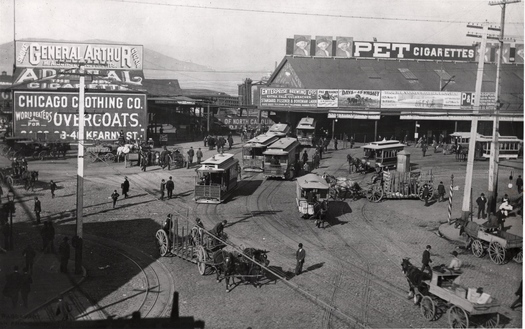As we approach the 150th anniversary of rail transit on Market Street next month, here’s another photo to contemplate and comment on. This is the Ferry Building in 1896. The one we know today opened in 1898, but before that, starting in 1875, there was a long shed at the foot of Market Street (a tad bit north, actually) that served as the connector between the ferries and surface transit. In those days on Market Street, that meant cable cars and horsecars.

Click on the photo to get a giant version that shows the great detail of this shot. It will take some time to download.
We’re looking out of a third story window at an intersection that no longer exists: Market, Sacramento, and East Streets. (This would be the northeastern corner of the Hyatt Regency Hotel today.) In the lower left, a cable car track swings from Sacramento onto East Street (later renamed The Embarcadero) and will then turn up Clay for the return trip (the direction of operation was reversed after the 1906 earthquake and fire to eliminate this “contraflow” move). Horsecars bound for Sutter Street compete with the giant combination cable cars that served routes on Hayes, Haight, Valencia, McAllister, and Castro Streets, all reversed on a double-track turntable.
Teamsters (in the literal definition of the word) weave their teams of horses hauling low-deck drays (the delivery trucks of their day) through the labyrinth of transit vehicles. Scores of people go to and from the ferries or about their business, almost all of them men or boys and not a single one without a hat or cap.
Then there’s the great period advertising, which speaks for itself. As Nancy Olmsted’s wonderful (but sadly, out of print) book, The Ferry Building: Witness to a Century of Change, 1898-1908, notes, the building at this location from 1875 to the mid-1890s did not have advertising on it, but when this shot was taken, construction was getting underway on the grand new terminal, so no one objected to some temporary billboards that helped mask the construction. Note the disused cable car tracks continuing straight along the axis of Market Street toward the bay, past the turning McAllister cable car and running into the Chicago Clothing Co. billboard, another indication that the terminal is temporary.
So what we have here is the 1890s version of the “interim” Transbay Terminal now nearing completion at Howard and Beale Streets.
This contorted track arrangement at the Ferry Terminal back then is perfectly described by noted Western rail historian Lucius Beebe, quoted by Olmsted as follows: “Horsecars, cable cars, and steam trains operated over an amazement of geographic locales crossing, meeting, receding, shuttling, connecting and converging upon one another like dancers in a pattern of bemused complexity. They wove back and forth across each other’s lines in a warp and woof of a gigantic fabric. … the Clangor of their coming and going … rattling over cobbles, Belgian blocks, asphalt, macadam, and steel switches and crossovers comprised a contrapuntal symphony of cosmopolis.”